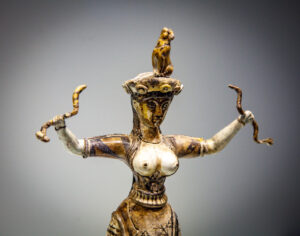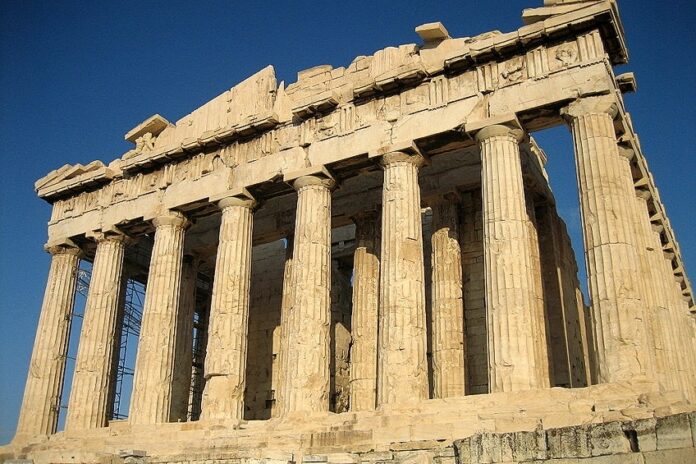Comparing Ancient and Classical Art
The Snake Goddess art and Bust of Nefertiti are two renowned pieces of art from distinct civilizations that showcase their unique styles, cultural values, and design elements. The Snake Goddess art, crafted around 1600 BCE, is a Minoan sculpture discovered in ancient Crete. It portrays a female figure holding snakes, draped in a long, flowing dress and a headdress. The sculpture’s material is faience, a ceramic material popular in the Bronze Age, and it stands at a height of approximately 12 inches.

In contrast, the Bust of Nefertiti is a limestone sculpture from the Amarna period of ancient Egypt, created approximately in 1340 BCE. It portrays the queen Nefertiti, the wife of Pharaoh Akhenaten, wearing a unique crown with a long neck and an exquisite face. The sculpture stands at around 20 inches tall. The Snake Goddess and the Bust of Nefertiti share some similarities and differences.
Both sculptures depict powerful female figures, but the Snake Goddess is more stylized and abstract, while the Bust of Nefertiti is more realistic and intricate. Although they use a blue and gold color palette, the Snake Goddess’s color scheme is more vibrant and playful, while the Bust of Nefertiti is more restrained and elegant.

Each artwork’s design elements reflect its distinctive style and place of origin. The Snake Goddess art incorporates curvilinear shapes, asymmetry, and flowing lines, which are typical of Minoan art. Conversely, the Bust of Nefertiti has a more balanced and symmetrical composition, with meticulous attention to detail and precise proportions, typical of Egyptian art.
READ ALSO: Police Seizes Nearly 1000 Ilegal Weapons and Ammo
The cultural values of the civilizations that created them are also evident in the works. The Minoans had a deep reverence for nature and goddesses, as well as a focus on beauty, sensuality, and creativity, which the Snake Goddess art embodies through its expressive style, feminine form, and playful colors. In contrast, the Egyptians valued order, stability, and eternity, as well as their rulers and gods, which the Bust of Nefertiti captures through its idealized portrayal of the queen, elegant style, and precise proportions.
Today, both works serve as significant cultural artifacts, offering insights into their respective civilizations’ art, culture, and history, and are celebrated for their beauty, craftsmanship, and artistic merit. The Heraklion Archaeological Museum in Crete houses the Snake Goddess art, while the Bust of Nefertiti is on display at the Neues Museum in Berlin, Germany.
To summarize, the Snake Goddess art and the Bust of Nefertiti are two exceptional artworks that highlight their civilizations’ unique styles, cultural values, and design elements. They continue to captivate and inspire people today, reminding us of the rich artistic legacy of ancient civilizations.
Classical Periods in Art History
Middle Ages (400-1300 CE): Visual arts flourished during the Middle Ages, reflecting the period’s aesthetic values. The Catholic Church heavily influenced the art of this period, and the wealthiest members of society commissioned artworks for religious purposes. Gothic architecture, with tall spires, pointed arches, and intricate stone carvings, became popular. Artworks during this period often featured religious themes, emphasizing symbolic representations of religious stories rather than realistic portrayals. The Middle Ages laid the groundwork for the development of art in the following Renaissance era.
Renaissance (1400-1600 CE): During the Renaissance era, there was a renewed fascination with classical art forms and the human form. Artists in this era aimed to create realistic and lifelike depictions of people and the world around them, popularizing the use of perspective and chiaroscuro to create the illusion of depth through light and shadow. Renaissance artists were interested in exploring the natural world through their art and placed great emphasis on individualism. The Renaissance movement subsequently influenced the Baroque era that followed.
READ ALSO: Controversial Actor Accuses 2baba of Not Giving Scholarship to Sound Sultan’s Children
Baroque Era (1600-1750 CE): Grandeur, dramatic lighting, and intense emotions defined the Baroque era. Baroque artists utilized light and shadow to produce dramatic effects and utilized ornate embellishment to convey the grandeur of the period. Artworks of this era were typically large and featured intricate details. The Neoclassical era that followed was influenced by the Baroque era.
Neoclassical Era (1750-1820 CE): Classical art of ancient Greece and Rome had a profound influence on the Neoclassical era. This period emphasized simplicity, order, and rationality and artists strived to create idealized depictions of the human form. The art of this era often portrayed historical and mythological themes and was marked by clean lines, symmetry, and balance. The Neoclassical period’s impact was evident in the Romanticism era that succeeded it.
Romanticism Era (1790-1860 CE): The Romanticism era was identified by its emphasis on emotion and imagination. Romantic artists placed importance on individualism, nature, and the supernatural. Natural landscapes were a frequent subject of Romantic art, and it explored themes of love, death, and the sublime. The era was a response to the Neoclassical period’s emphasis on rationality and order, and it had an influence on the art’s development in the 19th century.





